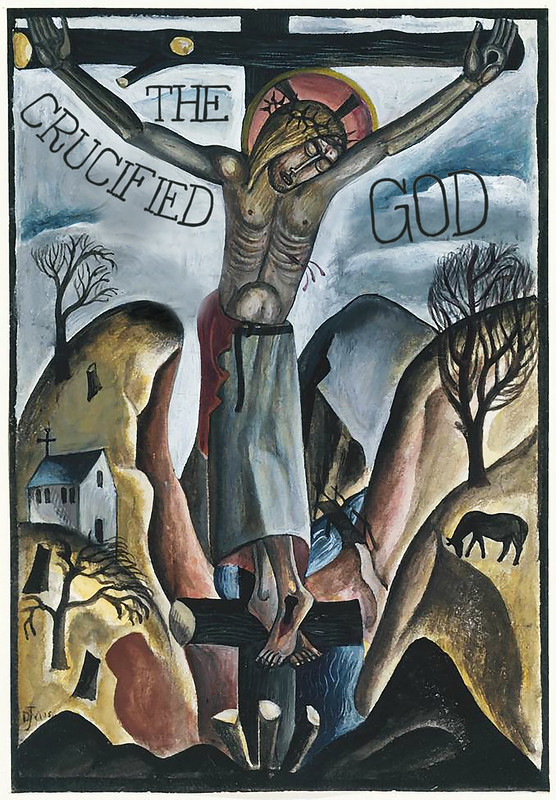The Crucified God
The Crucified God
Brian Zahnd
“When the crucified Jesus is called ‘the image of the invisible God,’
the meaning is that this is God and God is like this.”
–Jürgen Moltmann, The Crucified God
“Being disguised under the disfigurement of an ugly crucifixion and death,
the Christform is paradoxically the clearest revelation of who God is.”
–John R. Cihak, Love Alone Is Believable: Hans Urs von Balthasar’s Apologetics
“Jesus is the only perfect theology.”
–Brad Jersak
God is like Jesus.
God has always been like Jesus.
There has never been a time when God was not like Jesus.
We haven’t always known this.
But now we do.
–Brian Zahnd
I want to know who God is. I want to know what God is like. So what should I do? Read the Bible? Yes…but. The Bible is a big and complicated book and subject to what Christian Smith wryly calls “pervasive interpretive pluralism.” Smith is referring to the embarrassing plethora of contradictory interpretations from equally qualified and well-intentioned interpreters.
So what do we do? Where do we stand within Scripture in order to interpret the rest of the text? Genesis? Leviticus? Joshua? Revelation? What we need is a way to center our reading of Scripture – a vantage point from which to interpret the whole of Scripture. My humble suggestion is that this place is the cross. Not only do I advocate a Christocentric reading of the Bible, I contend that the cross is the most Christ-revealing moment in the Bible.
If we want to know what God is like, the best thing we can do is look at Jesus upon the cross. God is like that!
“The death of Jesus on the cross is the centre of all Christian theology. All Christian statements about God, about creation, about sin and death have their focal point in the crucified Christ.” –Jürgen Moltmann, The Crucified God
God is defined in Christ at the cross.
But the cross is a labyrinth of sacred mystery and we must not be too quick to glibly assert “this is what the cross means.” This is the seductive allure of “atonement theories.” Some of these theories I find inadequate, some I find repellent. Especially those theories that portray the Father of Jesus as a pagan deity who can only be placated by child sacrifice. The scorn heaped upon such theories of the cross is well-deserved.
This doesn’t mean I don’t ask myself how the crucified Christ saves us. I’ve mediated much on this question over the past five years – especially after writing Unconditional? (My book on forgiveness.)
Today I talk about the cross in terms like this…
On the cross we sinned our sins into Jesus and he forgave us.
On the cross Jesus became the sacrifice to end sacrifice.
On the cross Jesus became the scapegoat (lamb of God) who saves us from the foundational sin of scapegoating.
On the cross Jesus took the blame to save us from blaming.
On the cross Jesus shamed the principalities and powers of sacrificial religion and violent power (represented by Caiaphas and Pilate).
Through the cross Jesus judges sin, casts out satan, and re-founds the world.
In the cross of Christ the world is re-founded from an axis of power enforced by violence to an axis of love expressed in forgiveness.
At the cross Jesus gives the world a new organizing principle: Love.
At the cross Jesus gives the world a new telos: Peace.
At the cross we discover a God who shapes the world, not by coercion, but by love.
In his crucifixion Jesus achieves solidarity with all who suffer.
The cross is the only Christian theodicy.
In his crucifixion Jesus reorients the way of the world from the way of Cain (collective murder) to the way of Abel (co-suffering love).
At the cross Jesus reveals a God who would rather die than kill his enemies.
The cross is God’s alternative to the sword.
The cross is the coronation of the world’s rightful King.
In the crucifixion we understand that God was in Christ reconciling the world to himself…not the other way around!
At the cross Jesus doesn’t save us from God, he reveals God.
At the cross Jesus saves us from the coming wrath that is the inevitable result of following the ways of pride and power.
In his crucifixion Jesus joins humanity in death that we might join him in resurrection.
In his crucifixion Jesus tramples down death by death.
Though his death on the cross Jesus descended into Sheol/Hades that he might open the door to eternal life.
In his death and resurrection Jesus inaugurates the world to come – the world of New Creation.
And on and on and on and on…
I’m not interesting in bottling up the cross in a single atonement theory. What I want to do is gaze upon the mysterious beauty of the cruciform until I see the beauty of God take the form of a crucified man.
I approach the cross not to find a quid pro quo formula for salvation, but to contemplate the divine love of God which is my only hope of salvation.
I gaze upon the crucified Christ because this is who God is, this is what God is like.
I look to the cross to see God.
I don’t come to the cross to find a formula or a theory.
I come to the cross to find God.
The crucified God.
Look to Me, and be saved,
All you ends of the earth!
For I am God, and there is no other.
–Isaiah 45:22
BZ
(The artwork is Sanctus Christus de Capel-y-ffin by David Jones, 1925.)
